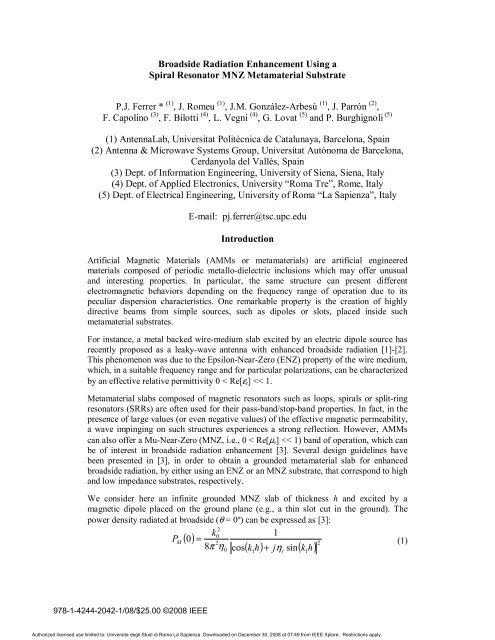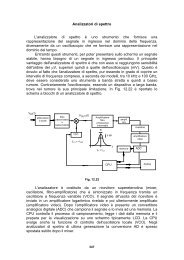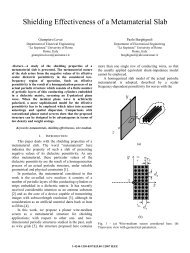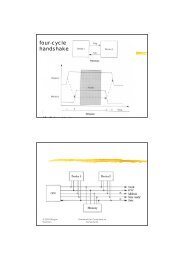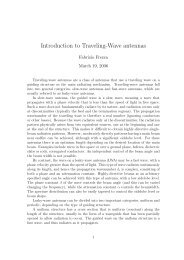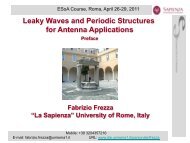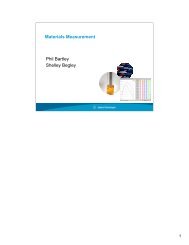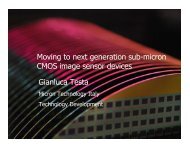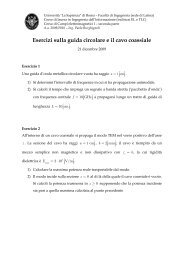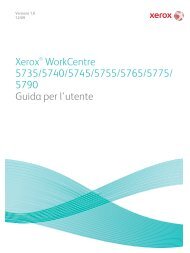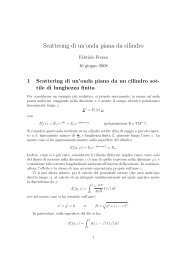Broadside Radiation Enhancement Using a Spiral Resonator MNZ ...
Broadside Radiation Enhancement Using a Spiral Resonator MNZ ...
Broadside Radiation Enhancement Using a Spiral Resonator MNZ ...
You also want an ePaper? Increase the reach of your titles
YUMPU automatically turns print PDFs into web optimized ePapers that Google loves.
where k1= k0n r= k0µrεrand ηrµr/ εr= . It is worth noting that, when the slabthickness is chosen as h opt = λ 1 /4 (with λ 1 = λ 0 /n r ), the broadside power density ismaximum.A power enhancement factor E P,M can be defined as the ratio between the broadsidepower density radiated in the presence of the grounded slab P M (0) and that radiated infree space P M,0 (0). It can easily be shown that, under the optimum condition h = h opt , itresults E P,M = 4/η 2 r , which can thus be maximized with a low-impedance substrate (e.g.,an <strong>MNZ</strong> substrate). For the suboptimal case (h < h opt ), the enhancement factor can beexpressed as:2k0122P ( 0)8πη0cos( k1h) + jηsin( k1h)Mr4EP,M= ==(2)2P ( )( ) ( ) 2M ,00k0cos k1h+ jηrsin k1h232πη0<strong>MNZ</strong> metamaterial substrate designIn order to obtain an <strong>MNZ</strong> substrate, a metamaterial slab composed of square spiralresonators printed on RO4003C strips is considered [4]-[5]. The xyz unit-cell dimensionsare 4×6×6 mm 3 , being 6 mm the thickness of the metamaterial slab and 5.6 mm the widthof the spiral resonator. The gap between adjacent layers of spirals is 4 mm. In thesimulations, the incident electric field is linearly polarized along +y axis, this is, parallelto the dielectric strips which contain the spiral resonators. When used as a reflector, themetamaterial slab is operating around 2.6 GHz (close to the resonance). This can clearlybe seen by observing the effective parameters (extracted according to the Nicolson-Ross-Weir formulas [6]) in Figure 1. In particular, the effective permeability µ r shows aresonance at 2.58 GHz (Figure 1a). It can be observed that the <strong>MNZ</strong> band starts at 3.74GHz (where Re[µ r ]= 0) up to 6.65 GHz (where Re[µ r ] = 1).It should be noted that for very low values of Re[µ r ], the optimum thickness of the slabcan be very large. The metamaterial slab we can build is only 6 mm thick, so it isexpected that the excited leaky waves be not dominant since the structure operates undersuboptimal conditions. However, by plotting the power enhancement factor as a functionof frequency using the extracted effective medium parameters, a peak occurs around 5.5GHz for the 6 mm thick slab, as shown in Figure 2.Fabrication and MeasurementsIn order to verify the previous results, a preliminary example of a magnetic dipole hasbeen fabricated on a 2λ 0 ×2λ 0 metal ground plane. The dimensions of the slot are 29×2mm 2 , and it is tuned around 5 GHz. The performance of the antenna has been tested withand without the square spiral <strong>MNZ</strong> substrate. A photo of the slot on the ground plane anda detail of the <strong>MNZ</strong> metamaterial slab are reported in Figure 3.Complete radiation patterns have been measured in the anechoic chamber. The measuredE- and H-plane patterns of the slot with and without the <strong>MNZ</strong> metamaterial substrate areshown in Figure 4. It can be observed that an enhancement of broadside radiation isachieved at 5.7 GHz. In particular, the directivity in the E plane has significantlyAuthorized licensed use limited to: Universita degli Studi di Roma La Sapienza. Downloaded on December 30, 2008 at 07:49 from IEEE Xplore. Restrictions apply.
increased, whereas the H-plane pattern is weakly affected by the <strong>MNZ</strong> slab. The slotitself has a directivity of 8.57 dB, whereas the directivity of the slot in presence of the<strong>MNZ</strong> substrate is 9.73 dB.ConclusionsThe broadside power radiation enhancement has been tested for the case of a magneticdipole in presence of an <strong>MNZ</strong> metamaterial substrate. In order to assess the theoreticalestimations, a slot antenna on a ground plane has been fabricated and an AMC composedof 1 layer square spiral resonators has been used as an <strong>MNZ</strong> metamaterial slab. Theradiation patterns have been measured in the anechoic chamber, achieving a gain indirectivity of more than 1 dB. However, it should be taken into account that the thicknessof the fabricated metamaterial slab (6 mm) is much smaller than the theoretical optimumthickness (hundreds of mm). The directivity of the antenna might be improved whenincreasing the number of layers of the metamaterial slab; in fact, in such a case, the leakywaves responsible of directive radiation are expected to be more significantly excitedgiving rise to the sought broadside power enhancement.AcknowledgementsThis work has been partially supported by the Spanish Comisión Interministerial deCiencia y Tecnología (CICYT) del Ministerio de Educación y Ciencia; and FEDER fundsthrough grants TEC 2006-13248-C04-01/TCM and TEC 2006-13248-C04-02/TCM, andby the European Commission through the METAMORPHOSE Network of Excellence(FP6/NMP3-CT-2004-500252).References[1] G. Lovat, P. Burghignoli, F. Capolino, D. R. Jackson, and D. R. Wilton, “Analysis ofdirective radiation from a line source in a metamaterial slab with low permittivity,”IEEE Trans. Antennas Propagat., vol. 54, pp. 1017-1030, Mar. 2006.[2] P. Burghignoli, G. Lovat, F. Capolino, D. R. Jackson, and D. R. Wilton, “3Ddirective radiation from a horizontal dipole in a homogenized grounded wire-mediumslab,” Digest 2006 IEEE AP-S Int. Symp. on Antennas and Propagation,Albuquerque, NM, 9-14 July 2006, pp. 2989-2992 .[3] G. Lovat, P. Burghignoli, F. Capolino, and D. R. Jackson, “Combinations of low/highpermittivity and/or permeability substrates for highly directive planar metamaterialantennas,” IET Microw., Antennas and Propagat., vol. 1, pp.177-183, Feb. 2007.[4] J. Parrón, J.M. González-Arbesú, F. Fortuny, J.M. Rius, G. Junkin, R. Villarino, andJ. Romeu, “Artificial magnetic reflector based on spiral resonators”, Proc. of theEucap-2006, Nice, France, 2006.[5] P. J. Ferrer, J. M. González-Arbesú, J. Romeu, and A. Cardama, ”Bidirectionalartificial magnetic reflectors at microwave frequencies”, Microw. Opt. Tech. Lett.,vol. 49, no. 8, pp. 1949-1953, Aug. 2007.[6] R.W. Ziolkowski, “Design, Fabrication, and Testing of Double NegativeMetamaterials”, IEEE Trans. Antennas Propagat., vol. 51, no. 7, pp. 1516-1529, Jul.2003.Authorized licensed use limited to: Universita degli Studi di Roma La Sapienza. Downloaded on December 30, 2008 at 07:49 from IEEE Xplore. Restrictions apply.


